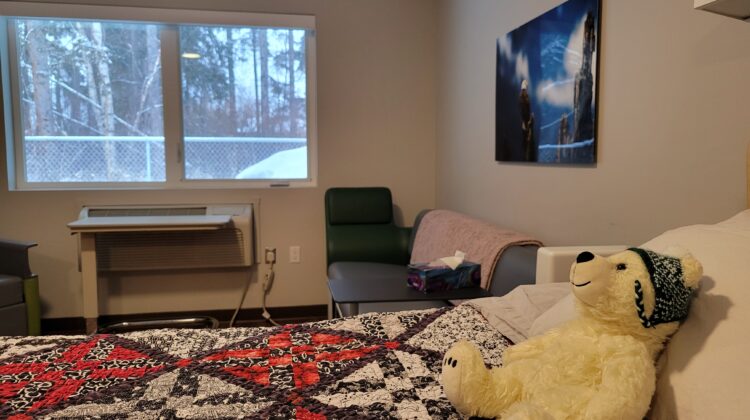
One of the private rooms for patients at the Prince George Hospice Palliative Care Society (Photo by Brody Langager, MyPGNow)
The National Hospice Palliative Care Association was established in 1987, and with it, the Prince George Hospice Palliative Care Society began work in the community. This is part one of a three-part detailed series delving into the Society.
The next installment will come out tomorrow (Wednesday, Feb 16th), and each part will focus on a different aspect of the organization.
The Prince George Hospice Palliative Care Society revised its name back in October to try and better explain the services that the organization offers, but many people still don’t fully understand the work they do.
“…we continue to meet the needs however we can…”
At a quick glance on their website, Hospice offers support programs not directly related to the Hospice House:
- Grief support aimed at both children and families
- Their Broken Circle grief support
- Grief and Grub for Guys
- Tea Time for the Soul
- Virtual Grief Support
- Immediate On-Site Grief Support
- Coffee for the Caregiver
- One on One Caregiver Support
- Community Volunteer Visits
- Caregiver Support Videos
- Remote Hospice
These are just to list a few, as according to Denise Torgerson, the Community Programs Manager, they move and adjust their content to fill the needs of the community.
“We are growing, we continue to grow, we continue to meet the needs however we can. More groups, more one-on-one, and people keep calling, so more volunteer trainings. So far we’re able to keep up and able to continue. There’s no waiting list here.”
“Some people grieve by sharing in the community, and emoting, and talking. Some people grieve by doing their grief. And some people are contemplative and reflective. So we’ve kind of found ways to help kind of every kind of person who’s grieving.”
Torgerson said that volunteers are a key part of the organization, and the lifeblood of the work they’re able to do.
She added that volunteering doesn’t necessarily mean you have to be involved with the grief support programs or the training attached to them.
“There are two tracks, so if you want to do indirect volunteering, like for the resale shop, or the Dream Home, or any of our fundraisers. It’s not mandatory that they take the training. It’s suggested, it’s good training.”
“But for community programs, and volunteering at Hospice House, and all that kind of direct contact with people, we have a palliative orientation training that we run every six weeks or so, and it’s a day and a half, a Saturday, and then half of Sunday. And then we have ongoing training that we do throughout the year,” said Torgerson.
She added that many new programs have been added since the pandemic began, but noted that none of this would be possible without community support.
“We have volunteers help in ways that I couldn’t have even imagined…”
Britney Szarka is the Volunteer Coordinator for Hospice and noted that they find different ways for people to volunteer all the time.
“So we have over 100 volunteers, right now I think we’re at 117 with our newest applicant.”
“We have volunteers help in ways that I couldn’t have even imagined, where they want to come in and bake freezer meals for us, so we can fill up our freezer and take that load off the care-aids,” added Szarka.
It was noted that they even have a volunteer in Victoria, as well as Australia, helping out with one on one grief support online.
“We have many different ways for you to get involved. If you’re looking to give back to your community as a whole, or to Hospice, we can find a way that you can contribute, and it’ll be meaningful for you. Whether that’s in the house directly helping the guests and families we serve, or out in the community. Or if it’s doing those more indirect roles of baking, or cooking, or at the resale shop.”
In the next installment, we’ll cover the fundraising portion of Hospice, and how vital the charity of others can be.
We are looking for volunteers to help with the @pghospiceresaleshop help us pick up the things so generously donated by the people of #PrinceGeorge for resale and supporting the #Hospice. pic.twitter.com/RBJIJDORxA
— PG Hospice House (@PGHospice) February 2, 2022
Hospice: More than Palliative Care: Part 1 - My PG Now
Read More

No comments:
Post a Comment